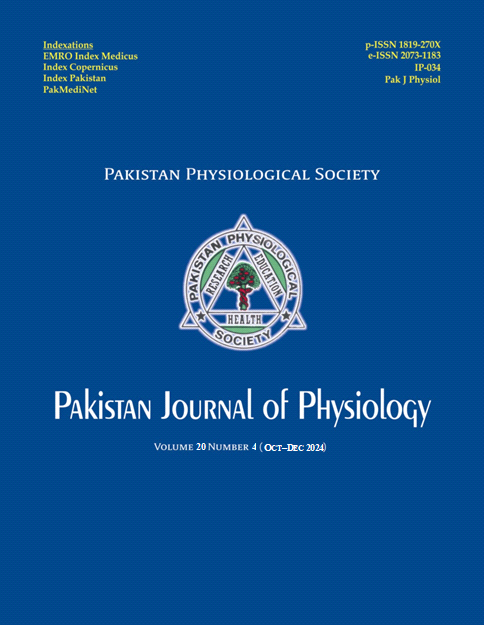COMPARATIVE THERAPEUTIC POTENTIAL OF ANTIBIOTIC LOADED GOLD AND SILVER NANOCONJUGATES IN CANCER THERAPY
DOI:
https://doi.org/10.69656/pjp.v20i4.1641Keywords:
MAP Kinase pathway, Metallic Nano conjugation, Tumor suppressionAbstract
Background: Nanomedicine is believed to be an emerging field to improve the efficacy of conventional chemotherapy. Nanoparticles (NPs), particularly drugs conjugated nanometals, have garnered attention as distinct drug carriers in terms of improved pharmacokinetic and pharmacodynamic properties compared to traditional formulations. This study aimed to investigate the potential of silver and gold-loaded antibiotic Azithromycin in demonstrating tumour-suppressing behaviour. Methods: Cells after being treated with different working concentrations of drugs/compounds Azithromycin, Au-Azithromycin and Ag-Azithromycin. After obtaining IC50 concentrations, treatment groups were further analysed for morphological changes under an inverted phase microscope after 24 and 48 hours of treatment. Finally RT-PCR (Reverse transcription polymerase chain reaction) was performed to evaluate the effect of these treatment groups on the regulation of Rapidly Accelerated Fibrosarcoma-1 (Raf-1), and Mitogen-Activated Protein Kinase 3 (MAPK3) involved in cancer proliferation. GAPDH was used as control gene which is a reference gene used in comparisons of gene expression data. Results: Compared to control, all the treatment groups showed very highly significant (p<0.001) down regulation of MAPK3 while Raf-1 exhibited highly significant (p<0.01) down regulation in all treatment groups. Conclusion: Azithromycin loaded with metallic nanoparticles such as gold and silver showed significant suppression of proliferative genes involved in the MAP kinase signalling pathway.
Pak J Physiol 2024;20(4):8-12, DOI: https://doi.org/10.69656/pjp.v20i4.1641
Downloads
References
Alavi M, Kowalski R, Capasso R, Douglas Melo Coutinho H, Rose Alencar De Menezes I. Various novel strategies for functionalization of gold and silver nanoparticles to hinder drug-resistant bacteria and cancer cells. Micro Nano Bio Asp 2022;1(1):38–48.
Abbas-Al-Khafaji ZK, Aubais-aljelehawy Q. Evaluation of antibiotic resistance and prevalence of multi-antibiotic resistant genes among Acinetobacter baumannii strains isolated from patients admitted to al-yarmouk hospital. Cell Mol Biomed Rep 2021;1(2):60–8.
Khorsandi K, Hosseinzadeh R, Sadat Esfahani H, Keyvani-Ghamsari S, Ur Rahman S. Nanomaterials as drug delivery systems with antibacterial properties: current trends and future priorities. Expert Rev Anti Infect Ther 2021;19(10):1299–323.
Fernández M, Orozco J. Advances in functionalized photosensitive polymeric anocarriers. Polymers (Basel) 2021;13(15):2464.
Nanayakkara AK, Boucher HW, Fowler VG Jr, Jezek A, Outterson K, Greenberg DE. Antibiotic resistance in the patient with cancer: Escalating challenges and paths forward. CA Cancer J Clin 2021;71(6):488–504.
Vila Domínguez A, Ayerbe Algaba R, Miró Canturri A, Rodríguez Villodres Á, Smani Y. Antibacterial activity of colloidal silver against gram-negative and gram-positive bacteria. Antibiotics (Basel) 2020;9(1):36.
Henriksen-Lacey M, Carregal-Romero S, Liz-Marza?n LM. Current challenges toward in vitro cellular validation of inorganic nanoparticles. Bioconjug Chem 2017;28(1):212–21.
Halawani EM, Hassan AM, Gad El-Rab SMF. Nanoformulation of biogenic cefotaxime-conjugated-silver nanoparticles for enhanced antibacterial efficacy against multidrug-resistant bacteria and anticancer studies. Int J Nanomedicine 2020;15:1889–901.
Takeda A, Takano N, Kokuba H, Hino H, Moriya S, Abe A, et al. Macrolide antibiotics enhance the antitumor effect of lansoprazole resulting in lysosomal membrane permeabilization?associated cell death. Int J Oncol 2020;57(6):1280–92.
Liu L, Cao Y, Chen C, Zhang X, McNabola A, Wilkie D, et al. Sorafenib blocks the RAF/MEK/ERK pathway, inhibits tumor angiogenesis, and induces tumor cell apoptosis in hepatocellular carcinoma model PLC/PRF/5. Cancer Res 2006;66(24):11851–8.
Liu YQ, Wang XL, He DH, Cheng YX. Protection against chemotherapy-and radiotherapy-induced side effects: A review based on the mechanisms and therapeutic opportunities of phytochemicals. Phytomedicine 2021;80:153402.
Yadav V, Talwar P. Repositioning of fluoroquinolones from antibiotic to anti-cancer agents: An underestimated truth. Biomed Pharmacother 2019;111:934–46.
Usman S, Ismail K, Hasan SS, Turab M, Jabeen A, Zehra D, et al. Azithromycin as potent inhibitor of cell migration in tumor cell line. J Hunan Univ Nat Sci 2022;49(6):44–51.
Toriyama K, Okuma T, Abe S, Nakamura H, Aoshiba K. In vitro anticancer effect of azithromycin targeting hypoxic lung cancer cells via the inhibition of mitophagy. Oncol Lett 2023;27(1):12.
Ozkan T, Hekmatshoar Y, Karabay AZ, Koc A, Altinok Gunes B, Karadag Gurel A, et al. Assessment of azithromycin as an anticancer agent for treatment of imatinib sensitive and resistant CML cells. Leuk Res 2021;102:106523.
Zehra D, Memon Z, Usman S, Jabeen A, Ismail K, Siddiqui RA. Low dose of Azithromycin enhances the anticancer efficacy of Sorafenib in HepG2 cell line. Pak J Zool 2022;54(3):1143–52.
Shokrzadeh M, Shaki F, Amani N. Effect of clarithromycin on enhancement of doxorubicin-induced cytotoxicity and apoptosis in A549 Tumor-cell Line. J Mazandaran Univ Med Sci 2022;32(213):42–54.
Amani N, Shokrzadeh M, Shaki F. Clarithromycin effectively enhances doxorubicin-induced cytotoxicity and apoptosis in MCF7 cells through dysregulation of autophagy. Adv Med Sci 2020;65(2):235–43.
Sk?odowski K, Chmielewska-Deptu?a SJ, Piktel E, Wolak P, Wollny T, Bucki R. Metallic nanosystems in the development of antimicrobial strategies with high antimicrobial activity and high biocompatibility. Int J Mol Sci 2023;24(3):2104.
Desai N, Momin M, Khan T, Gharat S, Ningthoujam RS, Omri A. Metallic nanoparticles as drug delivery system for the treatment of cancer. Expert Opin Drug Deliv 2021;18(9):1261–90.
Lan H, Jamil M, Ke G, Dong N. The role of nanoparticles and nanomaterials in cancer diagnosis and treatment: a comprehensive review. Am J Cancer Res 2023;13(12):5751–84.
Alafaleq NO, Alomari A, Khan MS, Shaik GM, Hussain A, Ahmed F, et al. Anticancer potential of gold nanoparticles (AuNPs) using a battery of in vitro tests. Nanotechnol Rev 2022;11(1):3292–304.
Gomes HIO, Martins CSM, Prior JAV. Silver nanoparticles as carriers of anticancer drugs for efficient target treatment of cancer cells. Nanomaterials (Basel) 2021;11(4):964.
Downloads
Published
How to Cite
Issue
Section
License

This work is licensed under a Creative Commons Attribution-NoDerivatives 4.0 International License.
The author(s) retain the copyrights and allow their publication in Pakistan Journal of Physiology, Pak J Physiol, PJP to be FREE for research and academic purposes. It can be downloaded and stored, printed, presented, projected, cited and quoted with full reference of, and acknowledgement to the author(s) and the PJP. The contents are published with an international CC-BY-ND-4.0 License.












